Douglas Adams recorded this (slightly hyperbolic) audio piece back in 1993 to promote the Voyager Expanded Books series. On “getting the book invented”:
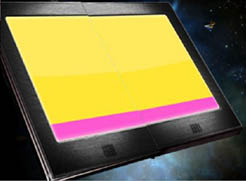 I recently saw the new Hitchhiker’s Guide to the Galaxy movie, which features as one of its central characters a very powerful electronic book – a guide to “life, the universe and everything.” Coming away, I felt a bit uneasy. Could this be the future of the book in the age of Adobe-Macromedia? As portrayed in the film, the Guide is essentially a compendium of Flash animations, with a little bit of text, and a wry British voiceover. Granted, it’s just a narrative device in a film, designed more for style than for content. But is this any less true in real life?.. with all these websites built in Flash, and all the Flash-enhanced garbage on television – especially in ads and sports coverage (notice how TV’s become a lot more like a video game?). The same goes for the film. Though chock-a-block with spiffy visual effects, and flavored with Douglas Adams’ unmistakable wit, it’s basically all style, all pose – visual fireworks for a passive viewer. We have only just started to explore the frontier of media-rich, networked books. But if “FlashAcrobat” becomes the writing tool of choice, that just might end up preempting any serious consideration of an active, critical role for the reader. Books become the half time show at the Super Bowl. Flash frenzy…
I recently saw the new Hitchhiker’s Guide to the Galaxy movie, which features as one of its central characters a very powerful electronic book – a guide to “life, the universe and everything.” Coming away, I felt a bit uneasy. Could this be the future of the book in the age of Adobe-Macromedia? As portrayed in the film, the Guide is essentially a compendium of Flash animations, with a little bit of text, and a wry British voiceover. Granted, it’s just a narrative device in a film, designed more for style than for content. But is this any less true in real life?.. with all these websites built in Flash, and all the Flash-enhanced garbage on television – especially in ads and sports coverage (notice how TV’s become a lot more like a video game?). The same goes for the film. Though chock-a-block with spiffy visual effects, and flavored with Douglas Adams’ unmistakable wit, it’s basically all style, all pose – visual fireworks for a passive viewer. We have only just started to explore the frontier of media-rich, networked books. But if “FlashAcrobat” becomes the writing tool of choice, that just might end up preempting any serious consideration of an active, critical role for the reader. Books become the half time show at the Super Bowl. Flash frenzy…
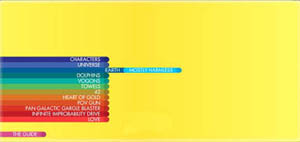
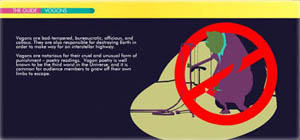
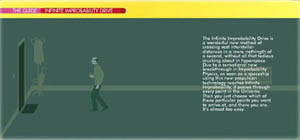
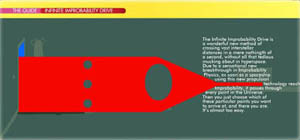
Paul Boutin, writing last week in Slate, makes draws a more encouraging parallel to the fictional Guide: Wikipedia. “..a real-life Hitchhiker’s Guide: huge, nerdy, and imprecise.” I had not been aware that Adams, before his untimely death in 2001, had experimented with his own web version of the Guide, a sort of proto-Wikipedia called h2g2, hosted by the BBC. Flipping through just a few of the articles, it’s interesting to see a collaborative work sustaining a unified authorial voice. The tone, not to mention the choice of subjects, comes across as unmistakably Adams – the ur-author – even though the guide was built by diverse contributors, in more or less the same fashion as Wikipedia. Here’s the intro paragraph from the article “The Problem with Driving Directions”:
“In the absence of in-car electronic route maps, driving directions are sets of instructions given to drivers in order for them to reach their desired destination. These basically come in two different forms: oral and written. Whether oral or written, they are widely used due to the fact that people often have no idea how to get to where they are going, and naturally assume that they are the only ones that do not know, and so ask someone else. Unfortunately, this other person tends not to know either.”
Building on Boutin’s comparison, you could argue that Wikipedia is simply imitating the tone and format of a paper encyclopedia, much as Adams’ followers in h2g2 are emulating the style of his novels. As a reference tool, Wikipedia may have far outstripped Adams’ project, but questions of accuracy and reliability persist. h2g2, on the other hand, sits much more comfortably in its skin, cheerfully acknowledging that it contains “many omissions,” and “much that is apocryphal, or at least wildly inaccurate.” A much more serious and important endeavor, Wikipedia is still wrestling with the anxiety of influence exerted by its forebear, the encyclopedia. Over time, will its voice change?
if:book
A Project of the Institute for the Future of the Book

I, too, was disappointed by the “guide” as portrayed in the movie (not to mention the movie as a whole).
“Moviefying” text has aways been difficult. Lots of films depict people writing letters, which gets boring after 3 or 4 seconds, so, inevitably the scene devolves into a voiceover, the camera perhaps focusing in on the thoughtful face of the letter writer.
The form factor of the “guide” in the film is excellent, though — maximizing readable area while offering a protective cover for the delicate screen. The Flash-y animations with silhouetted illustrations were absolutely lame by contrast. But, of course, the filmmakers were simply trying to give the audience something interesting to look at, not redesign the book.
The balance of text versus audio and visual content in the book of the future, I think, will be the crucial element. We can still read text faster than we can listen to it, so just because audio is possible doesn’t mean it will be the ideal way to convey information.
Cool bit of voyager history. Like how you use the audio on the blog. Do tell.
I for one, as a New Media writer, am happy to have Flash and Acrobat to work with and wonder at the slamming of these programs in this and other blogs. There’s room for everyone in this world. The more apps and opportunities for us creative people to explore and invent the futures of books the better! *1
My father, an ad exec, once told me the best way to have a successful gas station was to place it on a the fourth corner where three corners of gas stations already exist.
To a creator, the most beautiful thing about these two apps is that they supply free readers/players to anyone who wants one on any computer platform. For the first time, there is a wide potential audience for those of us who have been new media writing behind the scenes all these years with minimal outlets for our work.
And any time such a thing as a reference to e-books or future books shows up in a movie – all the better for those of us who would like to see the public start to recognize, embrace and consider new types of communication / writing. Free advertising for our cause.
Passivitiy in book reading is not always such a bad thing either, I should think. When I read something, even if I am not participating physically with it, my mind is interacting with it. I do not want to interact with everything I read. And I don’t necessarily want to go deeper into everything I read. *2 So, it seems to me, we should complain about bad content more than percentage of passivity to interactivity or percentage of words to pictures, animations, video and sound.
It stands to reason, too, that multimedia future books may not have as much text as 19th century novels designed to while away the day sans radio, TV and nearby community cafes. We who create toward the future, should watch out for those pesky shackling starus quo weights to the past. 19th Century writers didn’t have audio and video and animation to communicate with!
*1. No, I do not approve of the proposed merger of Adobe and Macromedia, for that goes against the idea of having as many players as possible creating tools for new media writers and artists. And, yes, I have written to my senators, congressman and the FTC about this – have you?
*2. My electronic design college students and I shared the Atlantic Monthy hyertext article by Wallace in April issue about talk radio. We all decided it was a really cool idea, and looked really cool, but that none of us had the time or inclination to go that deep into the subject. We all decided that the only people who would have time or interest in that multiple-layered footnoting style would be researchers on that particular subject. We all had addtional things we wanted to read and spend our time with. The irony of deep information in this information age is that few have the time for it and we each will be very discriminating about with what we share of our time to go that deep.
On this day, June 16 in 1990, Bloom’s Day, Bob Stein convened a group of people to meet at Voyager in Santa Monica, and talk about what e-books should be, and do, might do in the future; Happy Birthday, Expanded Books.